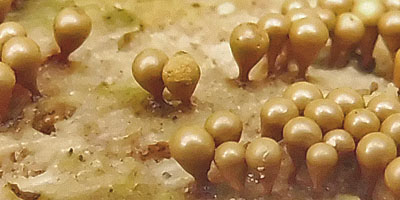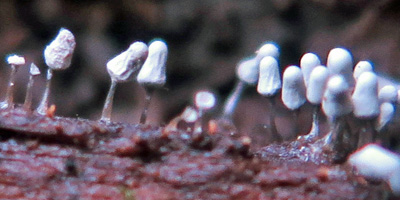
|
Myxomycetes: Overlooked Native Plants
The Myxomycetes or acellular slime molds can only be considered to be plants if one uses a very inclusive definition.
By Hubert Ling, Ph.D.
The Myxomycetes or acellular slime molds can only be considered to be plants if one uses a very inclusive definition. However, they have generally been studies by mycologists and botanists and are usually included in general botany books although DNA studies of slime molds suggest a closer relationship to the protozoa. The average New Jersey resident is most likely to encounter a slime mold by finding a bright yellow sporangium (spore filled reproductive structure) that has suddenly appeared on a compost pile or on a well-rotted log; this is the common organism Fuligo septica. The sporangium is formed from a plasmodium (a giant amoeba) when the giant cell runs out of its favorite food e.g.: bacteria, spores, protozoa, or other bits of organic matter.
 Above, fruiting bodies of Trichia decipiens . Below, fruiting bodies of Arcyria cinerea. Both about 1/8 inch or smaller.
Above, fruiting bodies of Trichia decipiens . Below, fruiting bodies of Arcyria cinerea. Both about 1/8 inch or smaller.

These giant amoebae have been known to scare people especially if they crawl into bedrooms overnight. The migration rate of a plasmodium going full speed is only about one inch per hour. Thus, finding a giant blob half way up your bedpost after the blob's overnight marathon would be a rare but not impossible item for the tabloids. To remove unwanted plasmodia simply sprinkle the cell with soap powder or just pick it up and move it back out into your garden.
If you want to grow a slime mold you can order a kit from most biological supply houses such as Carolina. The basic supplies needed are a bunch of banana peels and a number of cake pans, plant trays, or plastic shoe boxes which are water tight. In a pinch you could use 1-gallon milk containers cut vertically (a midsagittal cut as the anatomists would put it).
Line the bottom of the container with 2 layers of paper towels, flood with 1/2" of water then drain well.
Place 2 banana peels in a milk container or up to 6 peels in a 9" x 13" cake pan. Sprinkle the peels lightly with water and cover tightly with plastic wrap. If excess free liquid pools in the container at any time, drain this out. However, if the paper or the peels appear to be drying out add a little water; slime molds develop best in moist environments.
Store in a dark cool place and observe the cultures every day from about day 5 to day 25. The classical net-like appearance of the plasmodia should appear in some of your cultures. Banana peels from Panama generally do the best; we average one plasmodium for every 12-20 banana peels cultured. Peels from Costa Rica and Honduras also do well but 15 -30 peels may be needed for each plasmodium recovered. Bananas from Ecuador don't seem to give you any plasmodia at all; the reasons for these results are unclear. Your grocer may be able to tell you the country of origin of your bananas.
For the more adventuresome you can grow your own. Maintaining your plasmodia is a more difficult task. They are generally maintained on corn meal agar or moist paper towels and fed sterile rolled oats. Get the old fashioned type. The instant variety has been toasted and apparently doesn't agree with slime molds; one has to wonder how good instant oatmeal is for humans. Slime molds cultured indoors are generally maintained by using sterile techniques, sterile containers and sterile oatmeal.
Slime molds grown indoors are frequently bothered by contamination with fungi. Since slime molds can migrate at a reasonable rate, uncontaminated plasmodia can be procured by simply allowing the plasmodium to migrate away from contaminating fungi. Keep the plasmodium moist and every feed it a light sprinkling of sterile oatmeal. The oatmeal is easy to sterilize in a pressure cooker at 15 psi for 45 minutes. We generally sterilize oatmeal in Pyrex test tubes but any small glass container can be used. You can also try growing your plasmodia outdoors in their natural habitat on the compost pile and feed them oatmeal, banana peels, leaves etc. I've been told this can work but I've never tried it. If you find a number of plasmodia and you want growing tips e-mail me at (horticulture@npsnj.org). Plasmodia produced in your old banana trays will produce sporangia in a few days when they run out of oatmeal or microorganisms to eat. The organisms we commonly find are Physarum compressum, P. gyrosum, Fuligo septica etc.
Slime molds are relatively easy to identify down to species. Simply get the colored picture book and turn the pages. Keys are also available if you want to do it the "correct way". If anyone gets interested in such a project we could perhaps get out a publication. The only list for NJ that I know of was done in 1889!! An updated list would be a great science project for school.
References:
Martin, G. and Alexopoulo, C. 1969. The Myxomycetes. University of Iowa Press.
Stong, C. 1966. The Amateur Scientist: How to cultivate the slime molds. Scientific American, January, pp 116-121.